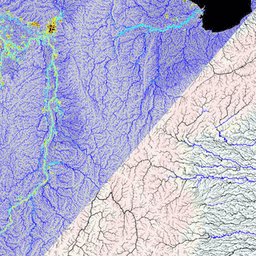
- 数据集可用性
- 1987-01-01T00:00:00Z–2017-01-01T00:00:00Z
- 数据集提供商
- Dai Yamazaki(东京大学)
- 标签
说明
MERIT Hydro 是一张新的全球水流方向图,分辨率为 3 角秒(赤道处约为 90 米),基于 MERIT DEM 海拔数据和水体数据集(G1WBM、GSWO 和 OpenStreetMap)的版本 1.0.3 派生而来。
MERIT Hydro 包含一种新算法的输出,该算法通过将实际内陆盆地与输入海拔数据中的错误造成的噪声分离,近乎自动地提取河流网络。经过最少的手动编辑后,构建的水文网络图在流量累积面积和流域形状方面与现有的质量受控河流网络数据集非常一致(参见论文中的图 9a)。河流简化的位置与现有的基于卫星的全球河道数据真实地对齐(见论文中的图 10a)。90% 的 GRDC 水位计的流域面积相对误差小于 0.05,这证实了划定的全球河流网络的准确性。流量累积面积的差异主要出现在干旱的河流盆地中,这些盆地包含在水位较高时偶尔会连通的洼地,因此导致分水岭边界不确定。
与现有的全球水文地理数据集相比,MERIT Hydro 在空间覆盖范围(北纬 90 度至南纬 60 度)和小河流表示方面有所改进,这主要是因为高质量的基准地理空间数据集的可用性有所提高。
您可以使用此 Web 应用直观呈现 MERIT Hydro 数据。 应用的源代码可供使用。
已知问题:
- 河流宽度(从 GWD-LR v1 更新):更新了宽度算法,以考虑子像素水分数。现在,系统使用 30 米水体地图以 90 米分辨率计算宽度。目前,在网状/分叉河段,河宽是针对每个河道单独计算的。应计算合并后的河流宽度。
- 水体地图:DEM 陆地海洋掩膜与水体数据之间存在一些不一致之处(例如沿海地区的新岛屿)。OpenStreetMap 水体图层的质量在所有区域并不一致。
- 渠道分叉:当前版本中未很好地呈现渠道分叉。假设每个像素只有一个下游方向。应考虑次要(或多个)下游方向,以表示三角洲地区、洪泛平原和网状河流中复杂的河流网络。
- 地下河道/隧道:应实施大型地下河道/隧道,以改善大规模的水平衡。
- 河流/湖泊分离:对于某些应用,需要更好地分离河流和湖泊。
- 海平面以下区域:沿海地区海平面以下的区域在调整后的海拔高度数据中未得到充分体现。
- 冰川上的流向:冰川上的流向未得到很好的表示,因为冰川中心线的高程高于冰川边缘。
- 补充数据:最好添加 GRDC 测量站、瀑布、水库等的位置。
数据来源:
频段
像素大小
92.77 米
频段
| 名称 | 单位 | 像素尺寸 | 说明 |
|---|---|---|---|
elv |
米 | 米 | 海拔 |
dir |
米 | 流向(局部排水方向)
|
|
wth |
米 | 河道中心线处的河道宽度。河道宽度采用 [Yamazaki et al. 2012, WRR] 中描述的方法计算,并对算法进行了一些改进/更改。 |
|
wat |
米 | 陆地和永久性水域
|
|
upa |
平方公里 | 米 | 上游排水面积(流量累积面积) |
upg |
上游像素数 | 米 | 上游排水像素(流量累积网格)。 |
hnd |
米 | 米 | 水文调整后的海拔,也称为“hand”(高于最近排水的高度)。调整高程以满足“下游不高于上游”的条件,同时最大限度地减少对原始 DEM 的必要修改。EGM96 大地水准面以上的高程以米为单位表示,垂直增量设置为 10 厘米。如需了解详细方法,请参阅 [Yamazaki et al., 2012 年,WRR]。 |
viswth |
米 | 河道宽度可视化图表。 |
使用条款
使用条款
如果您只是使用 MERIT Hydro,则只需引用该论文即可。如果您要求提供数据集的额外处理/编辑帮助,或者您的研究成果高度依赖于该产品,开发者会要求共同署名。
MERIT Hydro 已获得知识共享“CC-BY-NC 4.0”或开放数据共享“开放数据库许可 (ODbL 1.0)”许可。通过双重许可,您可以选择适合自己的许可。
如需查看这些许可的副本,请访问:
- CC-BY-NC 4.0 许可:限制较少的非商业用途。
- ODbL 1.0 许可:允许商业用途,但基于 MERIT Hydro 的派生数据应根据相同的 ODbL 许可公开提供。例如,如果您使用 MERIT Hydro 创建了洪涝灾害地图,并希望基于该地图提供商业服务,则必须根据 OdBL 许可公开提供该灾害地图。
请注意,上述许可条款适用于基于 MERIT Hydro 的“派生数据”,但不适用于使用 MERIT Hydro 创建的“作品 / 艺术品”(例如期刊论文中的图表)。用户可能拥有艺术作品的版权,并且可以分配任何许可,前提是所创作的作品不被视为“衍生数据”。
下载并使用数据即表示用户同意许可的条款及条件。尽管我们提供免费许可,但我们仍希望用户在未经作者明确书面许可的情况下,不要在其他网站上以原始格式重新分发整个数据集。
MERIT Hydro 的版权归开发者所有,2019 年,保留所有权利。
引用
Yamazaki D.、D. Ikeshima, J. Sosa、P.D. Bates、G.H. Allen、T.M. Pavelsky。 MERIT Hydro:基于最新地形数据集的高分辨率全球水文图 Water Resources Research,第 55 卷,第 5053-5073 页,2019 年,doi:10.1029/2019WR024873
使用 Earth Engine 探索
代码编辑器 (JavaScript)
var dataset = ee.Image('MERIT/Hydro/v1_0_1'); var visualization = { bands: ['viswth'], }; Map.setCenter(90.301, 23.052, 10); Map.addLayer(dataset, visualization, 'River width');
